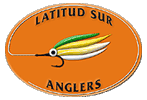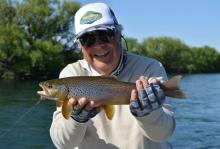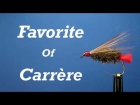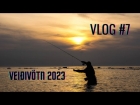Patagonian salmonids
The fascinating story of the introduction of salmonids into Argentina and the Patagonian waters told by local guide Heiko Schneider. Without the work done by people a century ago, Argentina would be a very different fishing destination... if any at all.
 Some words to the reader: This article is not meant to be scientific... or maybe a little bit. But since the majority of the GFF readers rather enthusiastic fishers and nature lovers rather than scientists, I chose more common descriptions than you will find in a biological text.
Some words to the reader: This article is not meant to be scientific... or maybe a little bit. But since the majority of the GFF readers rather enthusiastic fishers and nature lovers rather than scientists, I chose more common descriptions than you will find in a biological text.
You can read much more about Heiko Schneider and Argentina on the web site Latitud Sur Anglers.
An odd noise echoed over the vast lake, squeaking oars of a wooden dingy. The dark blue water reflecting a bearded face showing his arduousness. It seemed fruitless, even hopeless. For weeks he had been trying to catch one of those trout. No bite, no sign of fish. Strange...
So it might have happened, on a calm December day in 1902 on lake Nahuel Huapi, in Argentina. This pioneer didn't know that there were no trout in this lake, nor in any other. Even in the countless rivers and creeks, rich in aquatic life, trout & co where absent. Evolution decided that salmonids were not appropriate for these waters.
The indigenous species
These are the most common original Patagonian species, which are present in the most influenced provinces like Rio Negro, Chubut, Santa Cruz, Neuquen and Tierra del Fuego:
Persichtys trucha/colhuapiensis/altispinis/visiguerrae
Diplomystes viedmensi
Hatcheria macrei AKA bagre de torrente
Trichomycterus aerolatus
Jenynsia lineata AKA madrecita
Galaxis maculatus/platei AKA Puyen chico/grande
Geotria australis AKA lamprea
Odonthestes hatcherie/bonarienses AKA Pejerrei /Patagonian silverside
Aplochiton taeniatus/zebra
Gymnocharacinus bergi, which is declared as an endangered species.
First steps
It all begun around 1890 in Hurlingham, a suburb of Buenos Aires. Some British, obviously tired of playing cricket and polo, came up with the idea to stock the small arroyo Morron with rainbow trout. And so, admitting their British roots and maybe a glint of the master of its century, George Edward MacKenzie Skues, the Morron creek where the first ever stocked water in Argentina.
But not adapted to the hot summers, the unfortunate trout soon vanished out of the Moron.
Almost a quarter of a century earlier, in the year 1875, the young Argentine adventurer Francisco Moreno was exploring the Chilean and Argentinean wilderness. He revealed the absence of any fish worth to be describtéd as a fisherman's dream to fish for.
Now, knowing the extraordinary potential of those rivers in terms of sport fishing and commerce, he informed the Argentine government to consider the introduction of salmonids.
Scientific expertise
In the year 1892 French Ferdinand Lahille and Italian Felipe Silvestre were invited by the Argentine authorities. Both were biologists and soon started their work independently of each other. Lahille studied the Neuquen river and Silvestre started his scientific job further south, on the Santa Cruz river.
Somehow, the results from either was not satisfying or inadequate and the government decided to count on the American John Wheelock Titcomb, Chief of the Division of Fish Culture in the National Fisheries Bureau.
Years went by and finally 1903, after an adventurous journey, Titcomb arrived to the shore of lake Nahuel Huapi. After 9 months of scientific field studies, he analyzed his samples and notes and evaluated the ecosystem suitable for the introduction of salmonids.
Logistical challenge
Since the scientific field work was completed, Titcomb soon faced another hurdle: how to deliver those salmonid eggs from the USA to the far destination of lake Nahuel Huapi?
The transport would last two months by steamboats from New York to Buenos Aires, not to talk about the rough overland trails to the lake itself. It was a mission impossible to ship such a fragile freight without any cooling devices.
Achievements
Edgar Allen Tulian resigned from his position as a superintendent of the hatchery of Leadville Colorado to participate in this ambitious project.
He was in charge of all logistic duties. And so, weeks, maybe months went by, until Tulian got a genius idea: to use the British steamers, which where shipping Argentine beef to Great Britain by using onboard cooling compartments.
The shipment arrived after ten days to the harbor of Southhampton, England. After repacking the precious boxes into the British steamer, the journey continued for an additional 40 days or so, and arrived in Buenos Aires. Certainly an logistic masterpiece.
Introduction
The journey continued from Buenos Aires to Neuquen by train for two nights and one day. And finally on march 4th 1904, after 300 miles through the rough nature Patagonias, on stages and horse back, arrived Lake Nahuel Huapi.
A milestone was set.
Lake trout
Salvelinus namaycush 53,000 Eggs
Brook trout
Salvelinus fontinalis 102,000 Eggs
Landlocked Atlantic salmon
Salmo salar sebago 50,000 Eggs
Whitefish
Corgonus clupeaformis 1,000,000 Eggs
"As there are no game fish in this country, I recommend the introduction of both, large and smallmouth bass into the streams and lakes of the warmer zone of Argentina."
Those are Titcomb's original words when he made his first statement back in the U.S.A. Fortunately, such an invasion has never been realized. And would have brought all otoctone species to extinction.
Exept the Whitefish, which disappeared without any trace, the stocking succeeded.
In between 1904 - 1910 following additional species where introduced:
Rainbow trout
Oncorhynchus mykiss
Brown trout
Salmo trutta
Silver salmon/coho
Oncorhynchus kisutch
King salmon/chinook
Oncorhynchus tsawytcha
Sockeye salmon
Oncorhynchus nerka
Atlantic cod
Gadus morrhua
Backlash
The stock of brown trout, cod, and all Pacific salmon of the first shipment failed. There are notes and stories, true stories, of entire shipments of trout eggs which didn't make it to its "delivery address" because of hazardous transport routes or simply, because the ice, there to keep the freight well tempered, melted.
So, often the transport crews, in stead of leaving the hatched or damaged eggs next to the road, emptied the boxes into streams or lakes close by.
The most efficient accident happened on the Lake Gardiel in Patagonia, a windswept turquoise body of water, which now has a large number of rainbow trout.
Mission accomplished
Well, not quiet, we still missing one link to close the chain: Salmo trutta, still wasn't here!
Twenty long years after Titcomb's task force, Salmo trutta eggs where imported from Chile and planted widely throughout Argentina's south as well as "Tierra del Fuego," better known as the Fireland.
But thanks to Titcomb's zootechnical knowledge, breeding stations on lake Nahuel Huapi and later from Neuquen and "la Cumbre" hatcheries in Cordoba, as well from "Isla Pávon" delivered more eggs and juvenile salmonids for the stocking program.
In 1910, this remarkable project of shipping eggs in large numbers came to its end.
In 1980, the last ever shipment arrived from Denmark, Germany and U.S.A, and introduction from imported material was definitely terminated.
The present
Less known is it that the northern provinces like Cordoba, Juyui, Salta, and Tucuman as well were stocked back in 1907!
And introduction is done periodically, but unlike Patagonia, those creeks often hold "ready to catch" rainbows, and the "put and take" character is part of an highly developed tourist infrastructure.
Today, 100 years later, all intruders have successfullly adopted to (and formed) the ecosystem, and occupied an ecological niche, which with respect to evolutionary development is misplaced and doubtless influenced the natural habitats of otoctone species.
Patagonia will remain an interesting experimental ecosystem.
"Cabeza Acero"
That's what we call the "Steelhead" down here.
The Santa Cruz river, located in the province Santa Cruz is the only stream in Argentinaand Southamerica, where this anadromous rainbow occurs. This fact alone isn't worth mentioning. We could easily stock any appropriate stream with genetically enhanced eggs and the chance to get a searun mykiss would not be impossible.
But there is a discordance in historical written records whether the early introduced population developed into an anadromous form (which would be an unique biological exception) or whether the river was stocked with both anadromous and landlocked fish from Californian stocks.
We know that the first Steelhead shipment in 1904 failed, because of an early hatch of the eggs, which then was put overboard on the coast of Brazil.
The next mentioned delivery is dating back to May 6th of 1908, which was delivered to the "la Cumbre" hatchery in the Cordoba mountains. No further notes are available to any steelhead stocking activity, related to the Santa Cruz river. So it seemed that rainbows in this particular glacier fed stream has developed to an anadromous form, which until today is an exception and makes it to a unique biological event. It's certain that we find both forms in this river, which is periodically stocked with the anadromous form from the hatchery on the Pavón Island.
Well, you might say, steelhead are also caught in Chile! But those big rainbows, entering from the Pacific rivers, are all escapees from the sea farming projects and shouldn't be declared as "Steelheads"!
The End?
There is a flip side: the hydro-electrical dam projects "La Barrancosa" and "Cóndor Cliff" are not longer proposals.
When you are reading this, the last ever free flowing Argentine Patagonian river will be on its way to be tamed. Whether there will be fish ladders, we don't know yet. And again, all scenarios are thinkable: a flourishing developing landlocked form of the remaining chinook. There are tributaries for the Pacific salmon in both the lakes Argentino and Viedma
Or the extinction of the Namaycush population and resident rainbows of both lakes.
By the way, the first ever reported catch of an steelhead in this river was in 1968!
The DNA profile
Apparently, the origin of the first introduced salmonids came from the Baird fish hatchery on the Californian McCloud river and no named Oregon waters, as well as Denmark, France and Germany. Atlantic salmon stocks came from the Earl of Denbigh's fisheries in north Wales!
Once we had a nice experience: again somewhere in Patagonia we were informed that a lake (we can't reveal it's name...) contained "Dinamarquesas" (Danes), a quick growing hard fighting fish.
Not having any idea and not having heard about such a "breed", we passed by this mysterious place, and later on we came to the clue, that the ancestors of those fish were rainbow trout from the last shipments from Denmark, AKA "Dinamarka" (And just as a side note from the editor, who is Danish: rainbow trout is not natural in Denmark either, so these fish have originally come from the US!)
The Pacific salmon
There's no bigger phenomenon than the presence of the king salmon Oncorhynchus tsawytcha or chinook in Argentina.
Their spawning run is from the Atlantic ocean into the Santa Cruz river and into Lake Argentino and Viedma and their feeder streams. To reach the spawning grounds in a tributary of lake Viedma, the chinook have to take the right turn (literally) through the Leona river which connects the lakes to each other!
The first spawning chinook were spotted in 1996 and DNA data proved that those fish came from sea farming projects in southern Chile in the 80's.
The result of straying and escapes from farming experiments are periodic catches of chinook in the rivers Irigoyen and Rio Grande of Tierra del fuego, as well as the Rio Gallegos. The northernmost traveled chinook were caught by commercial fishers in nets off the coast of Uruguay!
Chinook introduction
In 1886 the first ever chinook salmon were introduced on Chile's coast, but the project failed. Returnees were never found.
Then, 92 years later, from 1978-1989 the Chilean authorities introduced chinook from the Washington's Kowlitz and Kalama rivers into the Santa Maria and Prat rivers in the Magallanes region in the southernmost part of Chile.
The descendants of these fish found themselves in nutrition rich waters and followed the south channel zone through the Beagle channel, as well through the Magallan Strait.
The first Chilean sea farming experiment dates back to 1977-1982 in the waters off the Chiloe island.
When I first fished the Rio Grande on Chile's Riesco island in the end of the 90's, the chinook were rather an exotic bycatch while stalking searun browns. Today, when autumn run starts, it's not seldom to hook into such bright, strong fighters in the 20 lbs. class. The Argentine Lapataia river as well is among the known chinook spawning grounds.
Chinooks in the northern flyfishing zone Argentines
Some of us might remember those trophy catches of huge chinook or cohos in Pacific basins like the Pico, Corcovado or spawning runs far up into Lake Puelo and Rio Futaleufú.
Those salmon were never stocked. They found their way through river and creek interconnections, which all have one destination: the Pacific. The main routes of Oncorhynchus tshawytcha from the Chilean Pacific coast to Argentina's spawning grounds are the Palena, Pascua, Yelcho, Baker, and Puelo rivers.
Another "sporty" enrichment are the escapees of rainbow trout, Atlantic salmon, coho and chinook salmon caused by an "Tsunami" in march 2007, triggered by a huge landslide in Chile's Aysen region. The 18 feet wave destroyed almost all open water net pens of the region.
There are no disagreements, that the entire colonization from the Pacific side consists of escapees from ocean farming projects, but there's one remarkable fact: just a minor percentage of the entire sea farming projects are focusing on Oncorhynchus tsawytcha.
Increased salmon production from annual 5 tonnes in the 80's to far over 100 tonnes today, didn't boost emigration of Atlantic salmon, coho and rainbow trout, which are so far the most commonly farmed fish. In stead our chinook is outnumbering the other farming escapees.
It seems that this fish is number one in adopting Pacific and Argentinean watersheds.
The invader, Oncorhynchus tsawhitcha, is object to a wide range of scientific studies. But so far, no results are available to show whether chinook salmon is host to fungus or deceases due to mislead farming practice, and jeopardize the otoctone species and brown, brook and rainbow trout when entering rivers during spawning run.
The chinook were preadapted to their novel marine and freshwater environments, because of similarities to equivalent north Pacific habitats.
Now, since they established self sustaining populations, the question remains: catch&release? Or should they be banned from spreading? And if so, why judge them in a different way to those invaders which where first introduced?
But, by the way a significant number of those spawners are caught by net fishers in the Ocean itself, legally or illegally, and not by sportfishers!
Patagonian waters will remain as an huge experimental ecosystem.
Nevertheless, all those who hooked with this unique place on earth, swept by the fierce winds and covered in an seemingly infinity of blue sky, those who enjoy hiking, fishing or birdwatching know that Patagonia, this unique place on our planet, is worth care and respectful treatment to conserve it for future generations.
References
Carla Riva Rossi-Enrique Lessa, Miguel Pascual/Provincia Neuquen-Ambiente Biolgico Ecologico Bibliografia- Maria Nilda Amalfi, Grupo Estudios de Salmonidos Anadromos
My special thanks go to
Carla Riva Rossi - Enrique Lessa und Miguel Pascual - Provincia Neuquen-Ambiente Biologico Ecologico Bibliografia - Maria Nilda Amalfi, as well as Grupo Estudios de Salmonidos Anadromos.
Read more about why you should register.
More content from the front page
Since you got this far …
… I have a small favor to ask.
Long story short
Support the Global FlyFisher through several different channels, including PayPal.
Long story longer
The Global FlyFisher has been online since the mid-90's and has been free to access for everybody since day one – and will stay free for as long as I run it.
But that doesn't mean that it's free to run.
It costs money to drive a large site like this.
See more details about what you can do to help in this blog post.














































































Comments
Hernan Like I sai
Hernan
Like I said: this article was not to be meant scientific, and some indeciveness contentwise might be the result of historical sources. My article was publish several years ago, there might be appeared some updated scientific paper. Just let the readers know what misinformation do you mean and feel free to complete this historical abstract or the present state of the area concerned.
But I do not understand what your note means, that a lot of Patagonian rivers are not controlled in order to prevent spawning runs.
best
Heiko Schneider
There is a lot of mi
There is a lot of misinformation in this article, and even internal inconsistency with respect to details, but it's still interesting reading. We see statements such as this: "When you are reading this, the last ever free flowing Argentine Patagonian river will be on its way to be tamed" but there are many Argentine Patagonia rivers that are not controlled in such as way as to prevent movement of trout and salmon, such as the Rio Gallegos, Rio Santa Cruz, Rio Coyle, Rio Chico, Rio Deseado - to name some larger ones in just one of the Patagonian provinces.
In my researches on
In my researches on the introduction of trout in Argentina have found no reference to the introduction of New Zealand or Tasmanian trout in the rivers of Argentina. But I believe that Argentinecommercial hatcheries have purchased fertilized Rainbow eggs from NZ
Dear Sir Were there
Dear Sir
Were there ever any Tasmanian or New Zealand Trout released in Chile.
I heard somewhere there was.
Any ideas??
J Horak
I just stumbled over
I just stumbled over the last comment and like to mention that beside the named lodges the "Latitud Sur Anglers Camp" offers exceptional fishing as well. Not as boring as elsewhere close to the Barancoso, but technical with small nymphs and even dry's.
The german issue of "Patagonian salmonids" got an additional chapter were I wrote about the true history and how the ancestors of the "Strobel Steelheads" really found their way into the lake.
No legends and marketing bullshit, but facts.
best
Heiko Schneider
Another magnificent
Another magnificent spot in Southern Patagonia is Lake Strobel, also known as Jurassic Lake. This lake is in western Santa Cruz Province (70 km east of the Chilean border) and both the lake and the Barrancoso river that flows into it are home to enormous Rainbows. These gigantic trout can be caught in the Barrancoso river with dry flies. Difficult to get to, I know of two lodges that cater to anglers, Laguna Verde Lodge and the Loop organization that has a camp close to the Barrancoso river.
Svoban, There is
Svoban,
There is no drawback in my article, its simply about the introduction of salmonides !
Unfortunately no baseline study about original species was done before the introduction. Therefore to valuate the current number of remaining or even STEADY indigenous population is vague. We know for sure there is one endangered species. But you are certainly right, the ecological impact was and probably still is an ecological disaster. But since I am not a fulltime scientist, I rather decided to give no room for any assumption about present state of indigenous fish but facts about the introduction.
Heiko
There is a drawback
There is a drawback of in this article. You did not mention what happen to the original fish species of Southern America after the introduction of salmonids. Flyfishermen are happy, but the impact to original ecosystem was catastrophic.
Hi Heiko, very, v
Hi Heiko,
very, very interesting to me. I didn't know anything about that and you wrote absolutely readable about that.
Thanks a lot.
Jan